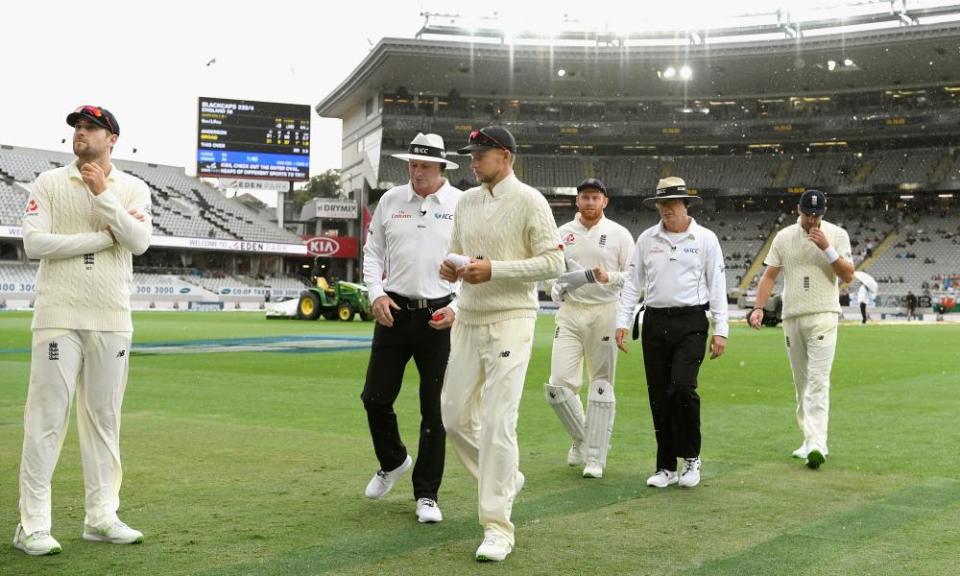England may need to rely on the rain until ECB gets its priorities right

It is taking a while for England’s batsmen to have a chance to get back in the saddle after being bowled out for a paltry 58 in their first innings. On Friday and Saturday there were just 26 overs of cricket at Eden Park and those batsmen dutifully shuffled around the field, no doubt noting that the ball was not jagging around quite so deviously as on Thursday afternoon and wondering whether they might do a bit better when their next chance comes along.
All this rain could be construed as good news for England supporters. Perhaps it was possible to spy a path out of this mess after all. It would be long and difficult and would probably require the batsmen to occupy the crease about six or seven times longer than they managed on Thursday. But survival was now a possibility. The batting coach, Graham Thorpe, acknowledged on Saturday evening “the weather gives us a glimmer”.
After an almost blank Saturday – there were 17 balls before the rain, enough for Henry Nicholls to register his half-century – there remained a minimum of 198 overs in this match. New Zealand led by 175 runs. With the forecast improving it seemed that England would have to bat for more than four sessions to save the game, an outcome that would fill Harry Houdini with pride and some surprise after that capitulation on Thursday. Not since 1902 has a side scoring 58 or less escaped with a draw in Test cricket – on that occasion the Australians were saved by rain in Birmingham.
Thursday’s collapse was jaw-dropping. The Kiwis could not believe what was happening. “Never in our wildest dreams did we expect that”, said Trent Boult. Jimmy Anderson had never witnessed anything quite like it either and it was hard to gauge whether he was indulging in some deadpan humour when he said: “It’s not ideal. But it happens”.
Those of us who are supposed to be experts were invited to deliver a simple and immediate explanation for such a hapless batting display. We did our best. It’s the woeful preparation in Hamilton; it’s too much white ball cricket; it’s the pink ball; the players are too jaded; or too rusty; or too blasé; or too pampered. They can’t block; they can’t battle and their feet looked stuck in drying cement. It’s the selectors; the coach; or the captain. Michel Barnier. It’s the ludicrous schedule on England’s longest tour since 1962-63; it’s the poverty of county cricket and the ridiculous domestic schedule, which will only get worse. We could even fall back on the excellence of Boult, who had the impudence to make the ball move at pace. Take your pick.
Test cricket, as opposed to the Test match venues in England, now appears to be low in their priorities
There is probably a grain of truth in most of the reasons above. My favourite probably centres on the scheduling. The players will not complain about this since some of them are eager to pop off to the Indian Premier League straight after this series and they recognise that they are getting well paid for their work by England and by their T20 franchises. They can hardly whinge. The multi-format players may be jaded; the Test specialists may be rusty. But this schedule is regarded as a matter of absolute commercial necessity. All those white-ball internationals have to be played and there is no time for any more red-ball preparation since the IPL is underway immediately after the Christchurch Test. How can the value of a balanced cricketing schedule ever compete with all that?
If England are trounced in this Test series the England and Wales Cricket Board will come under increasing scrutiny for agreeing to this winter’s schedule, which will add to the mounting disquiet over how they are running the game at home. Test cricket, as opposed to the Test match venues in England, now appears to be low in their priorities. In 2020 first-class cricket will, to an even greater extent, take place at the margins of the season, while the prime months for playing cricket – June, July and August – will be mainly devoted to two T20 competitions. Fast bowlers and spinners, which the Test team badly needs, are seldom required in first class cricket in April and early May; they may not be that essential in late September. Once again the prospect of commercial gain easily trumps the pursuit of a balanced schedule and a potent Test team.
The ECB seems more concerned that those counties with Test grounds, which are also the chosen venues for the new T20 tournament to be introduced in 2020, are in good shape come the brave new world. Glamorgan, for example, have just announced that “2017 has been a good financial year” with “an underlying profit of £1.646m”. The same release confirms that they have received £2.5m in compensation” from the ECB. Why? For “not applying to host Test matches from 2020 to 2024”. They are not the only Test match ground to receive substantial sums for not hosting a Test match. If this trend continues I’m hoping that someone will pay me not to write articles. Perhaps the ECB will oblige.
Knowledge of these handouts has led to increasing exasperation among those counties not on the Test rota, who do not appear to figure much in the ECB’s plans (though they have been promised an annual £1.3m handout from 2020. Why? For not hosting matches in the new T20 tournament, of course, and, ahem, agreeing to those new T20 plans).
But now those non-Test match counties are beginning to realise that they have been sleepwalking towards their own demise over the last couple of years. Back in Auckland any more sleepwalking from England’s batsmen and they head to Christchurch one down in the series.

 Yahoo Sport
Yahoo Sport 





































